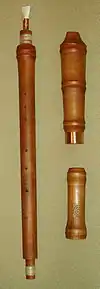Cornamuse
The cornamuse is a double reed instrument dating from the Renaissance period. It is similar to the crumhorn in having a windcap over the reed and cylindrical bore. In Syntagma musicum II (1619), Michael Praetorius writes: "Die CornaMuse sind gleich aus/und nicht mit doppelten/sondern mit einer einfachen Röhre/gleich den Bassanelli" (The cornamuse are similar to/and do not have a double, but rather a single tube (bore)/like the bassanelli.) This statement differentiates it from double bore instruments of the period like the sordun, kortholt and curtal. Praetorius did not include a woodcut of the cornamuse, but his depiction of the bassanello has a single bore and double reed. Another clue to its appearance is given in his description of the schryari: ("They...are nearly the same as the cornamuse in size and appearance".) Assertions by some modern writers about the cornamuse having a single reed stem from the misreading of "Röhre" (pipe, tube, duct, canal) as "Rohr" (reed).


Since the paragraph by Praetorius is the only clear description of the cornamuse and no period specimen has been found, all reconstructions of the instrument rely on a certain amount of conjecture.
The name is not to be confused with cornemuse, which is the French word for bagpipes.